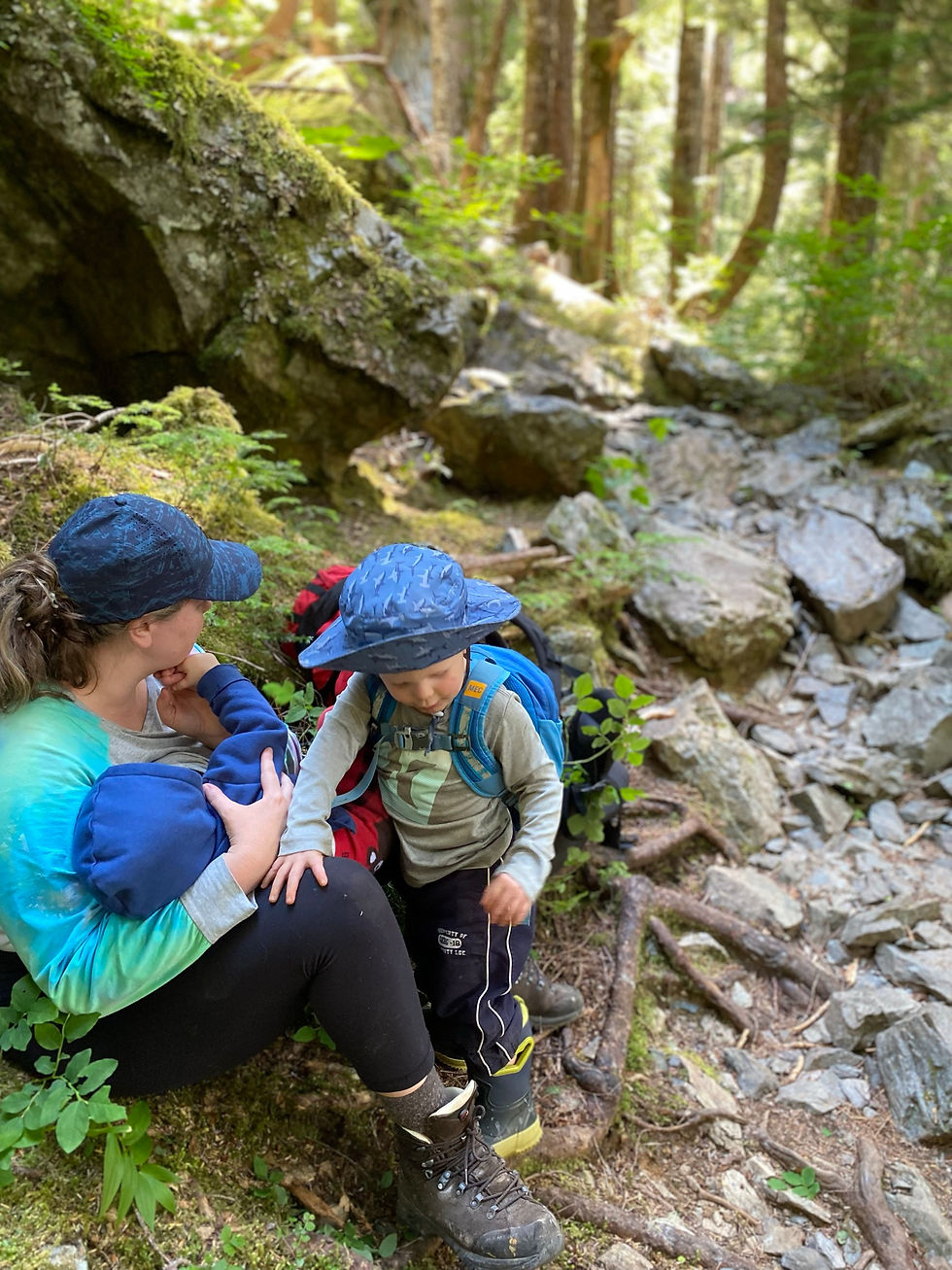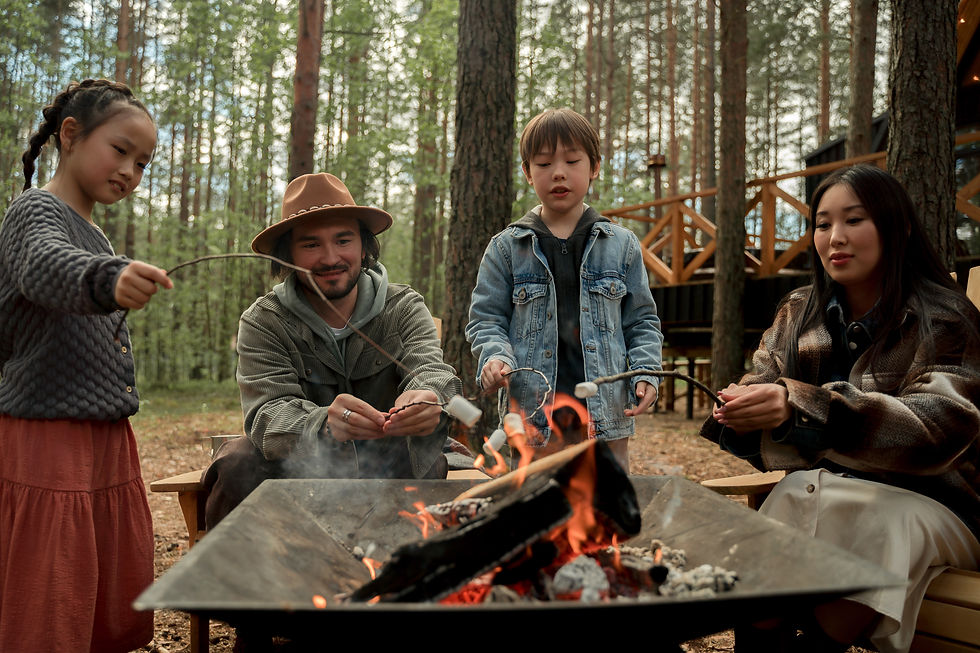How to Prevent Mastitis During Your Hike
- Ashley
- Jul 25, 2022
- 5 min read
Updated: Aug 4, 2022
There are a number of things that can bring your hiking or camping trip to a screeching halt, and one of those is mastitis. I consider mastitis the curse of breastfeeding, which I’ve had the misfortune of getting a handful of times.
One of those times was at the end of a short, overnight hiking trip. By the time we loaded up the car for the drive home, I was already experiencing pain in my left boob, and by the time we got in the door from the 2-hour drive, I had fevers and chills.
Thankfully, I lucked out that we were already home when I started experiencing these symptoms and wasn’t on a longer hike further in the backcountry or a multi-day trek back to the car.
I know exactly where I went wrong– actually, it was a combination of things that lead to the infection. So breastfeeding mamas, learn from my mistakes so that you don’t find yourself in a similar, painful predicament.

Milk stop
What is Mastitis?
Mastitis is defined as inflammation of the breast, which is usually caused by an infection. Although men and non-lactating women can get mastitis, it is much more common in breastfeeding mothers.
A high percentage of these women get it from milk stasis, where milk is not being fully drained from the breast either due to a clog (blocked duct) or from an insufficient feed (interrupted or short feed, improper technique, etc.).
The stagnant milk then grows bacteria and becomes infected. This is exactly what happened to me during our overnight hike (more on this to come).
Another way moms get mastitis is from bacteria entering the breast, which is usually through cracks or cuts on their nipples. Then when the baby nurses, bacteria from their mouths are transferred through these nipple wounds and into the breast causing an infection.
Nipple cracks/cuts are usually an indication of a poor latch. (If you’re a breastfeeding mom and currently experiencing painful latches, cracked/cut nipples, or any other difficulties breastfeeding, then I highly recommend you reach out to a lactation consultant, your local public health unit, and/or a La Leche League near you).

Image from Healthwise
Signs and Symptoms of Mastitis
Breast tenderness/pain
Burning pain while breastfeeding
Breast lumps
Breast swelling
Red/Reddish patches or streaking on breast
Fatigue
Flu-Like symptoms (aches, chills, headaches, generally feeling unwell)
Fever 101 F (38.3 C) or higher
It is important to see your doctor if you’re experiencing a fever over 101 F (38.3 C), have mastitis in both breasts (this is a medical emergency), have mastitis and you are not breastfeeding, experiencing symptoms for over 24 hours, or your symptoms are not improving within 48 hours of starting antibiotics.
*Leaving mastitis unresolved can lead to a breast abscess which usually requires surgical drainage.*
Now that we know what mastitis is and what the signs and symptoms are, let's go over how we can minimize the risk of it happening to us.

Image from Wix
Mastitis Prevention in Hiking Moms
So where did I go wrong? Well, there were a few things that lead to my mastitis. First off, I’ve already had mastitis before which increased my risk of getting it again. Next, my son was at that age where anything and everything would distract him while nursing.
The crashing waves, the other campers setting up their tents, and my oldest with his ‘not-so-quiet’ voice, would cause my nipple to be pulled from every direction as my son whipped his head around looking for the source of the sound.
Ensure baby is latched on properly and break latches with a finger
Allow baby to fully drain breast before switching to the other side
Alternate between different breastfeeding positions to drain different areas of the breast
Limit tight-fitting clothing that may impede milk flow
Wear your hiking backpack a little looser in the chest than you normally do and limit how much weight you’re carrying
Take frequent breaks to remove backpack and nurse baby while hiking
Avoid too-tight of bras and ones with underwires
Keep up with your regular feeds while camping and hiking
Change sweaty or damp bras and/or breast pads once finished your hike
Nurse or pump before a long drive/trip
So along with nipple trauma, I was also having interrupted feeds and not fully emptying my breasts while we were camping. This, coupled with the occasional skipped feed and heavy backpack straps on my chest, created the perfect storm.
I knew I had a clog by the time we got to the car, and I had planned on nursing before our 2-hour drive back home, however, our son was content and we had to seize the moment to get him in the car seat without a fuss. Unfortunately, by the time we got home, a large area of my breast was red and warm, and I was feverish.
After a week of antibiotics and trying endlessly to work out the clog (which, after breastfeeding two kids, I am pretty much a pro at now– so please feel free to ask for guidance) I was back to normal with more experience under my belt to share with you so that you don’t make the same mistakes as I did.
If you do end up in this unfortunate situation don’t hesitate to call your doctor and get it checked, treating the infection is much easier than dealing with an abscess.
Management and Treatment Tips
Antibiotics
Frequent feeds, do not stop breastfeeding from the infected breast, this will not affect your baby. Change up positions to drain different areas of the breast. Try dangle feeding to clear the clog
Plenty of rest and fluids
Hot compress and massage on the affected breast. I find hopping in a hot shower with my hand pump effective. I get the water as hot as I can handle on my breast and then massage downward towards the nipple, and then hand pump like crazy. Or submerge the breast into a bowl of hot water (as hot as you can bear) and massage downwards towards the nipple and hand express, working out the clog.
An over-the-counter anti-inflammatory to help with the pain (eg. Advil)
Talk to a lactation consultant or your doctor about taking sunflower lecithin regularly to prevent future clogs.
I have hiked and camped many more times since getting mastitis that day and thankfully haven’t had it since!
Fortunately, many of you won’t ever experience mastitis, even as breastfeeding mothers, but you can reduce the risk while hiking and camping by following these useful tips.
If it sounds daunting hiking with a breastfeeding infant or toddler, I am here to tell you otherwise. Pro tip: it is easier because you have an instant meal always ready to go!
So strap on that loose-fitting bra and pass off the heavy backpack to your partner and get hiking!
See you on the trail.

Snack time!
***This is for informational purposes only and does not replace your doctor’s advice or instruction.***
References
Bonyata, K. (2021, Nov 13). Plugged Ducts and Mastitis. Kellymom.com Breastfeeding and Parenting. https://kellymom.com/bf/concerns/mother/mastitis/
Cleveland Clinic. (2020, Nov 10). Mastitis. https://my.clevelandclinic.org/health/diseases/15613-mastitis
La Leche League International. (n.d.) Mastitis. https://www.llli.org/breastfeeding-info/mastitis/
Mayo Clinic. (2020, Jul 22). Mastitis. https://www.mayoclinic.org/diseases-conditions/mastitis/symptoms-causes/syc-20374829#:~:text=Mastitis%20is%20an%20inflammation%20of,%2Dfeeding%20(lactation%20mastitis).
NHS UK. (2019, Oct 29). Mastitis. https://www.nhs.uk/conditions/mastitis/
Image: Healthwise Staff. (2021, Jun 16). MyHealthAlberta.ca. https://myhealth.alberta.ca/Health/Pages/conditions.aspx?hwid=tp13147



Comments